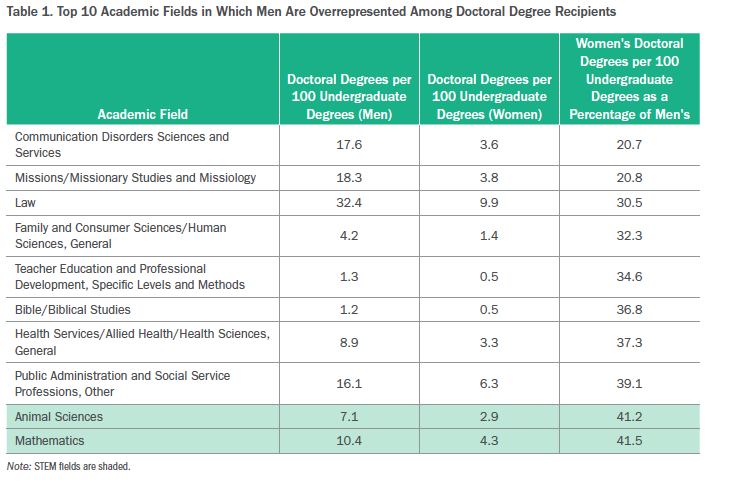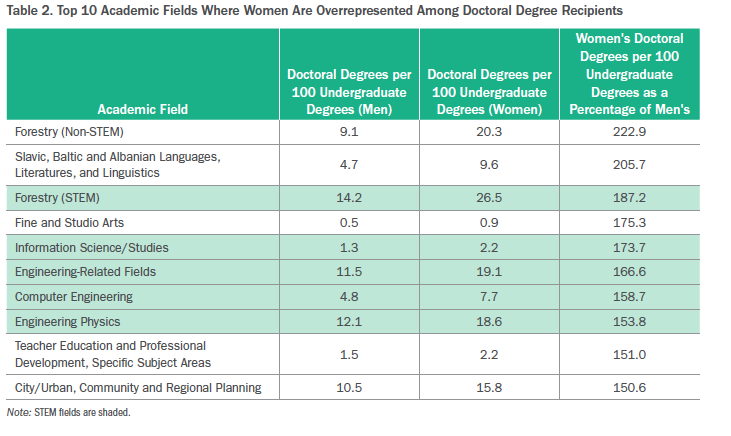You have /5 articles left.
Sign up for a free account or log in.
Conventional wisdom says that while there are many barriers for women pursuing advanced degrees, the “pipeline” to the sciences, technology, engineering and math is particularly leaky. But a new paper from the American Institutes for Research suggests that that overrepresentation of men Ph.D.s compared to women isn't a worse problem in STEM than in non-STEM fields, when preparation and interest are taken into account.
“That’s kind of the headline finding to me, that in three-quarters of academic fields there’s a gender imbalance towards men,” said Andrew Gillen, a senior researcher in the institutes’ education program and co-author of Exploring Gender Imbalance Among STEM Doctoral Degree Recipients. “You have a huge number of fields [beyond STEM] where you see a strong gender imbalance, and that’s definitely surprising, to me at least.”
To arrive at their results, Gillen and his co-author, Courtney Tanenbaum, a fellow education researcher at the institutes, didn’t just focus – as other research has – on the total number of men and women receiving doctoral degrees in STEM and other fields. Arguing that such an approach is only valuable if enrollment of men and women in degree programs is equally split, they aim instead to compare the number of “prepared and interested” men and women – those who majored in STEM as undergraduates – to the number of eventual Ph.D. recipients.
Using data from the Education Department’s Integrated Postsecondary Education Data System (IPEDS), Gillen and Tanenbaum calculated the number of doctoral degrees awarded per 100 bachelor’s degrees in scores of disciplines. (They averaged the number of baccalaureate degrees awarded in each year from 2002 to 2007, and did the same for Ph.D.s awarded from 2010 to 2012).
In the animal sciences, for example, seven Ph.D.s were awarded to men for every 100 baccalaureate degrees. For women, that figure was just about 3 out of 100 – 41 percent of the Ph.D. earning rate for qualified and interested men, as defined by the study. (A rate of 100 percent indicates perfect gender balance). The authors argue that figure is much more telling than a one-to-one comparison of Ph.D.s awarded to men and women in the animal sciences in the relevant time period: 71 and 70, respectively.
Applied to 135 disciplines, the analysis paints an interesting picture: Men are overrepresented in 103 fields, or 76 percent – and not just in STEM. In fact, the STEM fields are slightly more gender-balanced than non-STEM fields. Among the 55 STEM fields analyzed, men are overrepresented in 75 percent and women are overrepresented in 26 percent. In the 80 other fields, men are overrepresented in approximately 77 percent and women are overrepresented in 23 percent.
The top 10 academic fields in which men are overrepresented among doctoral degree recipients include just two STEM disciplines: animal sciences and mathematics.

Interestingly, the top 10 fields in which women are overrepresented among doctoral degree recipients include five STEM fields, as defined by the study: forestry, information science, engineering-related fields, computer engineering and engineering physics.

Among STEM fields, the researchers found that the biological and biomedical sciences had the biggest gender imbalance, skewing male, and that engineering – contrary to popular belief – is relatively gender-balanced.
The authors say that their approach illustrates there is “a considerable loss of women candidates between the bachelor’s and doctoral degrees.” They recommend data-driven approaches to retaining student interest, and recommend a “qualitative understanding of student experiences” to aid to those efforts.
Gillen said the study didn’t look at why women don’t go on to receive Ph.D.s in greater numbers, such as whether women drop out of Ph.D. programs at higher rates than men or simply don’t start them in the first place. But he said his data suggest that intervening early, at the undergraduate level, could reap the best results. And that's key because this study does not consider why more female students aren't completing undergraduate degrees in various disciplines.
“Efforts should be focused mostly at the undergraduate level, if you want to correct those gender imbalances,” he said. “Because once you get to the doctoral level, the gender imbalances aren’t that bad compared to the rest of the academic fields.”





